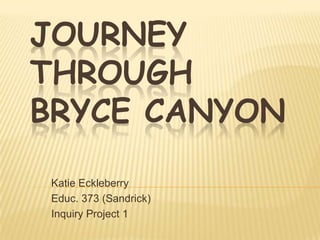
Weather Protection
- 1. JOURNEY THROUGH BRYCE CANYON Katie Eckleberry Educ. 373 (Sandrick) Inquiry Project 1
- 2. MY EXPERIENCE Over the summer I traveled to Arizona and Utah with my grandma to visit my Aunt Jennie and Uncle Gary. Throughout the trip we visited many places including the Grand Canyon, several national forests, the Vermillion Cliffs, and Glenn Canyon to name just a few. One of my favorite places that we visited was Bryce Canyon. There were so many breathtaking rock formations that were so beautiful.
- 7. QUESTIONS THAT I HAD ABOUT OUR JOURNEY: How did the rock formations and canyon form? If formed by water, where did the source of water come from? What types of components make up the rock formations? What gives Bryce Canyon its vibrant colors?
- 8. CONNECTION TO INDICATORS 4.3.5: Describe how waves, wind, water, and glacial ice shape and reshape the Earth's land surface by erosion of rock and soil in some areas and depositing them in other areas. 4.3.6: Recognize and describe that rock is composed of different combinations of minerals. 4.3.7: Explain that smaller rocks come from the breakage and weathering of bedrock and larger rocks and that soil is made partly from weathered rock, partly from plant remains, and also contains many living organisms.
- 9. FORMATION CONSTRUCTION “Bryce Canyon was not formed from erosion initiated from a central stream, meaning it technically is not a canyon. Instead headward erosion has excavated large amphitheater-shaped features in the Cenozoic-aged rocks of the Paunsagunt Plateau.” “Wind is an effective form of erosion for many locations. However, for Bryce Canyon wind has little effect on the creation and destruction of the various shapes.” Bryce Canyon National Park. (2009). Retrieved September 8, 2009, from Wikipedia: http://en.wikipedia.org/wiki/Bryce_Canyon_National_Park TravelWest. (2002). Bryce Canyon National Park Geology . Retrieved September 8, 2009, from BryceCanyon.com: http://www.brycecanyon.com/geology.html
- 10. FORMATION CONTINUED “Because soils at Bryce Canyon are very dry, much of the water runs off the surface. Only the top inch, or so of soil absorbs rainfall before it starts to run off.” At Bryce Canyon, water in the form of ice, is the most efficient form of erosion for breaking rock into smaller pieces. The Paunsaugunt Plateau receives around 100 inches of snowfall and 200 days of freeze/ thaw each year. This means that everyday a small amount of snow melts and runs into the joints and freezes at night. An ice wedge is formed in the joints as the water freezes and expands. The joint will break after the wedge has caused a large enough gap. This type of erosion is called frost wedging. TravelWest. (2002). Bryce Canyon National Park Geology . Retrieved September 8, 2009, from BryceCanyon.com: http://www.brycecanyon.com/geology.html
- 11. WATER SOURCES Since Bryce Canyon is not really a canyon, it was not formed by a main water source. (It is actually the eroded edge of Paunsaugunt Plateau.) The Paria River and its tributaries are still carving the areas of Bryce Canyon today. Softer cretaceous rocks that are loosened by erosion, are carried away by the Paria River.
- 12. ROCK COMPONENTS “The hoodoos at Bryce Canyon are carved in the Claron Formation. Limestone, siltstone, dolomite, and mudstone make up the four different rock types that form the Claron Formation. Each rock type erodes at different rates.” TravelWest. (2002). Bryce Canyon National Park Geology . Retrieved September 8, 2009, from BryceCanyon.com: http://www.brycecanyon.com/geology.html
- 13. WHERE THE COLORS COME FROM: The pink color of the rocks is caused by rust. Tiny particles of iron in the rock rust when they are exposed to air. This process creates all different shades of red and pink. Late afternoon and early morning light enrich the natural colors and deepen the shadows of the rocks.
- 14. OTHER INTERESTING INFORMATION! It took 65 million years for wind and water to sculpt the Bryce Canyon into the amzing cathedrals, temples, spires, and arches. “Bryce Canyon was established as a National Park in 1928 and named after Ebenezer Bryce, an early Mormon settler, who homesteaded in Bryce in the mid 1870's. In about 1880 Ebenezer and family left the Bryce Canyon area, moved to the Gila River Valley in Arizona and established the town of Bryce.” Works, Z. (2006). Bryce Canyon History. Retrieved September 8, 2009, from Bryce Canyon National Park: http://www.zionnational-park.com/bhistory.htm
- 15. REFERENCES Biff Baird, J. R. (2001). B is for Bryce Canyon. KC Publications. Bryce Canyon National Park. (2009). Retrieved September 8, 2009, from Wikipedia: http://en.wikipedia.org/wiki/Bryce_Canyon_National_Park Bryce Canyon National Park, Utah. (2009). Retrieved September 8, 2009, from About.com: http://gosw.about.com/od/nationalandstateparks/a/bryce.htm TravelWest. (2002). Bryce Canyon National Park Geology . Retrieved September 8, 2009, from BryceCanyon.com: http://www.brycecanyon.com/geology.html Works, Z. (2006). Bryce Canyon History. Retrieved September 8, 2009, from Bryce Canyon National Park: http://www.zionnational- park.com/bhistory.htm